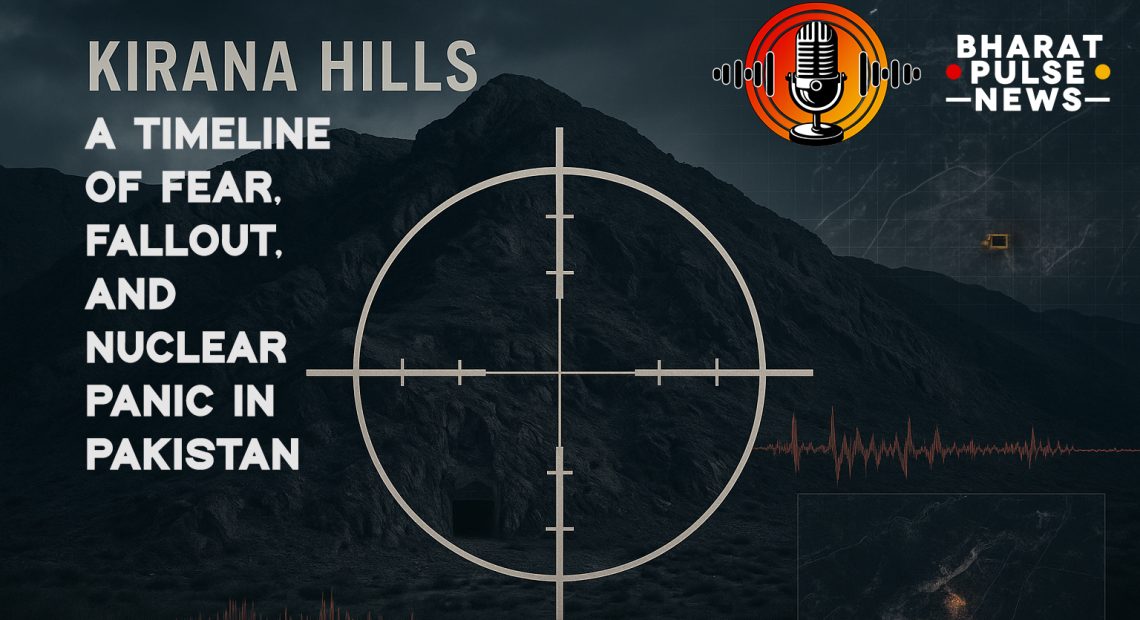
Did India Strike Kirana Hills? A Timeline of Fear, Fallout, and Nuclear Panic in Pakistan
In the dead of night on May 10, 2025, the geopolitical chessboard in South Asia tilted violently—without a formal declaration, without a tweet, and without a press briefing. At approximately 1:30 AM IST, an Indian missile reportedly struck Kirana Hills, a mountain-enveloped site long rumored to house Pakistan’s nuclear arsenal. For decades, intelligence analysts and military observers have speculated about the deeply-buried facilities tucked under these hills near Sargodha. That speculation turned into palpable alarm as soon as explosions were reported, followed by a 4.0 magnitude seismic tremor logged by global seismographs at 1:44 AM IST.
The quake’s epicenter was eerily close to the Kirana complex. And for those familiar with nuclear physics, the 4.0 magnitude registered immediately raised eyebrows—it is, after all, the exact tremor strength historically associated with a 1 kiloton underground nuclear explosion. Was it a detonation? Was it a secondary blast from fissile material? Or was it just tectonic coincidence?
Before analysts could finish their theories, events escalated. By morning, Pakistan’s Prime Minister had frantically dialed the United States, the Organisation of Islamic Cooperation (OIC), and European leaders, brokering a hurried ceasefire. No parade from ISPR. No poetic military sermon. Just silence. Quiet, nervous, suspicious silence.
And then came May 11.
A plane associated with the U.S. Department of Energy—an agency equipped for radiation detection and nuclear event verification—was spotted in Pakistani airspace. In parallel, an Egyptian Air Force Cargo Plane reportedly landed in Pakistan after departing from China. Speculation soared when intelligence chatter claimed the plane was carrying Boron, a neutron-absorbing material used in case of nuclear leakage containment.
Was Pakistan reacting to a breach? A threat? A feared nuclear incident?
Let’s break it down.
What Really Happened: A Fact Check Timeline
Did India Strike Kirana Hills?
Yes.
Multiple satellite analysts, open-source intelligence platforms, and military observers confirmed a precision strike on the access point to the Kirana Hills nuclear complex. While official Indian channels have maintained strategic ambiguity, evidence of debris, disrupted communication infrastructure, and emergency military mobilization in the area strongly suggest a deliberate strike. The fact that this was the only high-value location targeted on that night further strengthens the case.
Was it a BrahMos Missile?
Highly unlikely. India won’t act this irresponsible knowing it can cause a heavy damage to the structure and radiation leak possibility amplifies significantly.
The BrahMos missile, India’s famed supersonic cruise missile, is known to produce a seismic footprint of around 2.0 to 2.5 on the Richter scale when it impacts hard targets due to its kinetic and explosive force. Based on available seismic data, there were no officially recorded earthquakes in Pakistan with magnitudes between 2.0 and 2.5 on May 9 or May 10, 2025.
Moreover, no heat signature was observed in satellite thermal imagery post-strike. A BrahMos typically produces a distinct thermal bloom due to its high-speed impact and fuel combustion, which was missing in this case. That further eliminates the possibility of BrahMos being used.
Was it a genuine Earthquake?
Highly likely
Finally, most geological observatories and defense experts have pointed out that the 4.0 magnitude event was consistent with Pakistan’s tectonic activity, especially in the seismically active Balochistan–Hindukush region. The coincidence of timing may have triggered speculation, but science and intelligence both lean toward a natural seismic cause.
Did an Egyptian Cargo Plane Land in Pakistan?
Yes.
Confirmed through flight tracking data and regional airspace logs, an Egyptian Air Force Cargo Plane did land in Pakistan, reportedly having departed from China. The buzz about it carrying Boron—a neutron absorber commonly used to manage radiation containment—is speculative. There’s no official record or photographic evidence to verify this claim.
However, Egypt and China have been engaged in ongoing military exercises since April, and such cargo movements might well be part of pre-planned logistics.
Was a U.S. Energy Department Aircraft Seen in Pakistan?
Yes, but not as it seems.
The aircraft in question was once registered under the U.S. Department of Energy, which uses specialized planes for radiation detection, nuclear verification, and fallout tracking. But here’s the catch—it was sold to Pakistan years ago and now operates under Pakistani command, likely for domestic training or nuclear safety operations. So while the aircraft was seen, it wasn’t dispatched by the U.S., nor does it confirm any nuclear emergency.
Devil’s Advocate: What If It Was BrahMos?
Let’s suspend disbelief for a moment and assume the unconfirmed theory: India did use a BrahMos missile to strike near or at the Kirana Hills nuclear tunnel. What would the consequences be? Could it destabilize nuclear cores? Could it trigger a leak? Let’s examine each possibility.
Can a BrahMos Shake Nuclear Cores?
No. Not even close.
Nuclear warheads are engineered with multiple layers of fail-safes, shielding, and shock absorbers. The fissile cores (typically plutonium or uranium) are housed within reinforced casings inside deep underground vaults, often built to survive bombings, natural disasters, and transport mishaps. Even the kinetic force of a BrahMos—immense as it is—is nowhere near the pressure or precision required to initiate fission or destabilize nuclear components.
BrahMos can obliterate surface-level bunkers, seal entrances, or disable command infrastructure, but not compromise a nuclear warhead’s core integrity through proximity alone.
Can It Cause a Radiation Leak?
Yes, under specific conditions.
If the strike leads to:
- Structural collapse of the tunnel systems,
- Direct hits on maintenance or handling areas,
- Or accidental triggering of secondary explosions (e.g., nearby fuel or ammo),
…then it’s plausible that radiation could escape through ventilation shafts or breached containment units. This would not be a nuclear detonation, but rather a radiological dispersal—a scenario akin to a “dirty bomb” or industrial-level hazard.
However, these conditions are unlikely unless the warheads were being actively handled, poorly stored, or the missile penetrated much deeper than expected.
Was the Seismic Activity Due to Cores getting disturbed?
No, and that’s important to understand.
In this case, global seismological agencies attributed the quake to natural tectonic stress, not to any explosion or missile impact. Pakistan lies within a geologically unstable zone, and such tremors are not uncommon—particularly in Balochistan and northern Punjab, which are not far from Sargodha.
The 4.0-magnitude earthquake that occurred at 1:44 AM IST on May 10 had its epicenter at latitude 29.67°N and longitude 66.10°E, with a shallow depth of 10 km. Shallow earthquakes like this are typically associated with tectonic stress release near the Earth’s surface.
In other words, the quake may have been real, but unrelated to the missile strike.
Could a Normal Missile Do Similar Damage To The Tunnel?
If it wasn’t a BrahMos, then what did India fire? Could a less powerful, conventional missile or smart munition create the same level of panic and structural impact?
Yes.
India possesses a broad arsenal of precision-guided munitions, many of which are designed for bunker penetration, high accuracy, and minimal collateral damage. Here are some examples:
- SPICE-2000 (used in Balakot strikes, 2019):
An Israeli-origin glide bomb system with Indian modifications, capable of deep penetration and precision targeting, without generating large surface explosions or thermal blooms.
Ideal for targeting hardened underground facilities without alarming the world with fireballs. - Gaurav & Garuthmaa series (Indian DRDO air-dropped bombs):
Indigenous smart bombs designed for pinpoint accuracy and modular payloads, which could have been used to disable a tunnel entrance or ventilation shaft. - SANT Missile:
India’s homegrown air-launched anti-tank and bunker missile, capable of striking from a distance with deep impact.
Any of these weapons could have caused localized destruction, avoided thermal detection, and left the world guessing—especially if fired in a covert mode during nighttime operations.
So Was One of These Used?
Only India knows—and India won’t tell.
And rightly so. Strategic ambiguity is not just a tactic, it’s a message. By not naming the weapon, India avoids:
- Giving away tactical details,
- Revealing the extent of its missile program’s evolution, and
- Forcing Pakistan to choose between admitting vulnerability or inventing a cover-up.
The question Pakistan must now grapple with is not “What hit us?” but “What else can hit us that we don’t see coming?”
Conclusion: The Message That Mattered
Whether India launched a BrahMos, a SPICE-2000, or an indigenous precision bomb, no one call tell with surety but one thing is certain — Pakistan heard the message loud and clear. And it wasn’t through diplomatic cables or press conferences. It was through a targeted impact near Kirana Hills, the nerve center of Pakistan’s nuclear bluff.
Did India trigger a radiation leak? Probably not.
Did it destabilize Pakistan’s nuclear warheads? Highly unlikely.
Did it cause panic and trigger a midnight diplomatic scramble? Absolutely.
The brilliance of the strike wasn’t in its scale — it was in its psychological precision. It didn’t matter whether radiation leaked. What mattered is that Pakistan feared it did. And that fear was so real, so immediate, that it forced them to reach out to the very countries they fantasize about defying, pleading for a ceasefire before daylight exposed what really happened.
The presence of a radiation detection aircraft, the hurried arrival of a foreign cargo plane allegedly carrying Boron, the silent military mobilization, and the seismic paranoia — all point to a regime that had no idea what hit it, but knew exactly what it could have been.
So to every loudmouth in Pakistan’s political and military establishment who daydreams on television about turning Indian cities into radioactive wastelands, here’s your reality check:
You blinked. You begged. And you backed off.
You now know that India doesn’t need to nuke you to shut you up.
One well-aimed missile at a tunnel is enough to remind you who the grown-up in this neighborhood is.
And next time a Pakistani general thinks of mouthing off a nuclear threat, may he remember the cold, trembling silence that followed the night when Kirana Hills shook—not only because of an explosion, but because of fear.
Because in modern warfare, it’s not about how many bombs you drop.
It’s about how convincingly you make your enemy believe you just might.


















